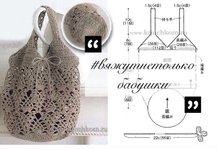
Crocheted napkins are a beautiful accessory for the home, which gives a stylish, somewhat classic, color to the entire interior. In addition, knitted napkins are associated with comfort, home, the care of loved ones.
Such napkins are not at all a relic of the past, as many think. They can be seen in almost every magazine about design and interior, moreover, they are quite actively knitted in our time, and in addition to the fact that there are innumerable possible models of napkins, they regularly come up with new types of these beautiful things for the home. All this can be connected by both experienced and novice knitters, most importantly, be patient and have the right knitting patterns.
How to crochet napkins: schemes with a description
In search of interesting crochet patterns for crocheting napkins, you can find the most unusual varieties of these products that will not just differ in their shapes (round; oval; square; rectangular; diamond-shaped), dimensions (large, like mini tablecloths; small, like cup holders ; ordinary, medium size), knitting methods (small or large knitting; sirloin knitting; napkins made of motifs; Irish lace), but also with decoration methods (sunflowers, irises, pineapples, butterflies, roses, grapes, geometric shapes and much more).
One way or another, the final result depends on the chosen knitting technique, the degree of crochet ownership, the desire of the knitter, and much more. But we will consider the most different models of napkins and how to crochet them, which can suit the masters of various levels.
Simple
The simplest crochet napkins are obtained when choosing simple repeating patterns and a simple shape. For example, some rectangular or round napkins knit easily and quickly, while helping to fill your hand for more complex and interesting knitting patterns.
- Sun circle

A beautiful napkin that will look great in any color, and not even in one. It is quite simple to knit, and to make it even easier, step-by-step photographs of the work process are useful.
Materials for work:
- cotton yarn of the main and contrasting color;
- hook suitable for yarn;
- scissors;
- large embroidery needle with a large eye.
Working process:
We make the ring a thread of the main color and fix the thread.
1st row: make two air loops.
We tie the ring with eleven double crochets.
Connect the ring. Pull the thread by tightening the ring, and then tie the single crochet into the first loop of the row.
2nd row: Make three air loops. Knit a single crochet in the same row.

Knit two single crochet stitches in each stitch of the first row. You should now have 24 loops. Knit a single crochet loop in the first loop of the row, thus closing it.
3rd row: make three air loops. Knit two single crochet stitches in the next row, then one double crochet in the next row, and again two double crochets in the same row. You should now have 36 loops. Knit a single crochet loop in the first loop of the row, thus closing it.

4th row: Make three air loops. Knit two single crochet stitches in the next row, then one double crochet in the next row, and again two double crochets in the same row.
You should now have 48 loops. Knit a single crochet loop in the first loop of the row, thus closing it.
The final row: Make a chain of three air loops. Tie a single crochet in the same row. Make two air loops. Knit two single crochet stitches in the same stitch of the bottom row. Skip two rows. Then again, knit two single crochet stitches into the same stitch of the bottom row. Knit like this in a circle. Finish knitting by stretching the thread through the loop and cutting it.

Napkin decoration
Take a thread of contrasting color. We pass the hook into one of the rows (closer to the outer edge of the napkin) and pull out the air loop. Now we pass the hook into the next loop of the row and knit another air loop. Repeat these steps until we get to the first loop. We pull the thread through the loop, cut it. Insert the thread into the needle and thread the thread into the first loop as shown in the photo. Make a stitch in the last loop and finish the job. A simple crochet napkin is ready.

- Napkin path

A great option to start with is simple paths to the table. They play the role of napkins, but at the same time look cool and like tablecloths. Let's take a closer look at how to crochet them.
Napkin Size:
36 x 120 cm.
Materials for work:
- yarn (100% cotton; 65 m / 50 g) - 350 g each in yellow, orange and turquoise;
- hook number 5.
Art. C / N
Each row start with 3 vp lifting instead of the 1st art. s / n and finish 1 tbsp. s / n at the last vp replace the previous row.
Knitting density
14 p. X 8 p. = 10 x 10 cm.
Working process:
For each napkin, execute a chain of 50 vp + 3 vp lifting and knit the main pattern.
After 120 cm from the start row, finish the job.
Oval
The oval shape of crocheted napkins looks classically beautiful. Usually these are large napkins that contain interesting complex thematic drawings, or floral silhouettes typical of these products, geometric shapes. One way or another, interesting oval napkins crochet with descriptions and patterns, which we will consider below.
- Festive mood

A large napkin with a pattern of Christmas bells in sirloin technique will surprise guests and will please all home with a cozy festive mood.
Napkin Size:
Diameter 49x84 cm.
Materials for work:
- yarn (100% cotton; 330 m / 50 g) - 150 g red;
- hook number 1.25.
Knitting pattern for napkins:



Knit in a filet pattern. Each cell of the pattern consists of 3 p. Empty cells consist of 1 tbsp. s / n (or patent, or art. s 2 / n) and 2 c.p. Filled cells consist of 3 tbsp. s / n (or patent article s / n, or article s 2 / n).
Knitting density:
15 cells in width and 17 p. in height = 10 x 10 cm.
Working process:
Complete the initial chain of 34 c.p. + 3 vp lifting and knit according to the pattern.
Assembly
Stretch the track, moisten and allow to dry.
- Rhombus path

A diamond-shaped napkin can be considered a cross between oval and rectangular products. In the interior, this kind of tablecloth will look quite interesting and fresh. Such a napkin can cover the middle of the dining table, or decorate the chest of drawers. Let us consider in detail how to crochet a napkin of such an unusual shape.
Napkin Size:
33x55 cm.
Materials for work:
- yarn (100% cotton; 280 m / 50 g) - 60 g pink and slightly white;
- hook number 1.5.
Pattern fillet knitting napkins:

For 1 empty cell, perform 1 tbsp. s / n and 2 vp, for 1 filled cell - 3 tbsp. s / n Each row begins with 3 vp lifting instead of the 1st art. s / n and end with 1 additional Art. s / n in the 3rd military unit lifting the previous row.
The arrow on the diagram indicates the midline, the rows end in a mirror image.
After the 37th row, the middle of the part will be reached. Then read the diagram in the opposite direction and complete the 37–1st rows. In this case, the increase becomes a decrease.
For additions and decreases see the job description.
The numbers on the diagram indicate the rows.
Border knitting pattern:

The diagram shows part of the border, continue the series by analogy.
Each circular row begins with 1 vp lifting and finishing 1 connection Art. For clarity, the border diagram shows cells of a filet pattern. At the end, in the places marked on the diagram of the filet pattern in red, perform 3 tbsp. b / n white thread. To go from the cell
if necessary, carry out a chain of 3 vp to the cell
Working process:
Complete the initial chain of 19 c.p. + 3 vp lifting and knit according to the pattern filet pattern.
To add 2 empty cells at the beginning of the row: perform 11 vp lifting, then 1 tbsp. s / n in the 9th v. from the hook, 2 vp, 1 tbsp. s / n in the last column of the previous row.
For an increase at the end of a row: 2 vp, 1 tbsp. with 4 / n in the loop of the base of the last knitted column, 2 vp, 1 tbsp. from 4 / n to the 3rd link of Art. with 4 / n.
To decrease the filled cell at the beginning of the row: skip the diminished cells with the compound. Art.
To increase the end of the row: leave the diminished cells untied.
Tie the finished part in circular rows according to the border pattern, while the 1st and 3rd circular rows are knitted with a pink thread, and the 2nd row with a white thread. To change the color, attach a new thread at the arrow with the connection. Art.
Assembly:
Paste the track on the substrate, grabbing each picot with a pin, sprinkle with starch and let dry.
Square
Crocheted square napkins look gentle and beautiful. Add harmonious colors and beautiful knitting, interesting floral motifs and other decorative elements here - you will get a real work of art.
- Flower frame

A wonderful combination of elements, as well as an interesting volumetric effect at the edges of this square napkin, sets it apart from many other crocheted square items that are similar to each other.
Napkin Size:
29x29 cm.
Materials for work:
- yarn (100% cotton; 387 m / 50 g) - 10–20 g each of white, lilac and blue;
- hook number 1.
Knitting patterns for napkins:
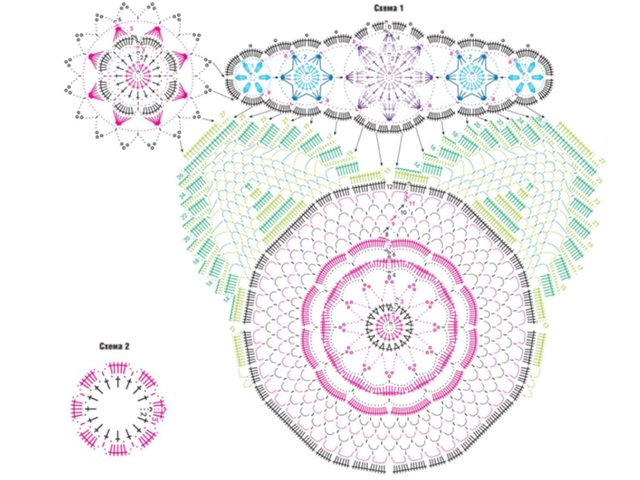
Working process:
For a central motive, perform an initial chain of 8 vp with lilac thread and lock it in the ring using the connection. Art. Run 3 vp lifting instead of the 1st column, then tie 17 tbsp. s / n in the ring and finish 1 connection. Art. in the 3rd c. lift = 1st row.
Continue work according to scheme 1, with each circular row starting from the indicated number of VP lifting and finishing 1 connection Art. or 1 tbsp. s / n If necessary, go to the beginning of the next circular row with the connection. Art.
At the end of the 5th circular row, attach the white thread and knit the 6–12th circular rows.
Then knit each corner separately in rows in the forward and reverse direction with a white thread, each time attaching a white thread with a joint. Art.
Run the 13–27th rows (in the diagram for clarity, are given in green).
For each side of the square, knit 5 motives: complete a chain of 6 vp, lock it in a ring with the help of a joint. Art. and knit according to the scheme 4, 2 or 1 circular row. At the same time, in the last row in the places indicated by the arrows, connect the flower with the previous motive.
For each side, execute 1 medium motif with lilac thread and 2 blue motifs on both sides of it.
The motives of each side are additionally connected with a white thread 8 chains of VP (marked in red on the diagram).
Then, tie each side part with a white thread next to b, at the same time connecting with the central part at the places indicated by the arrows in the diagram.
For each corner motive (4 parts), use a lilac thread to carry out a chain of 6 vp and lock in the ring using the connection. Art. Run 3 vp lifting instead of the 1st column, then tie 15 tbsp. s / n in the ring and finish 1 connection. Art. in the 3rd c. lift = 1 circular row.
Continue to work according to the pattern, while in the 6th circular row attach the part to the central and lateral motifs in the places indicated by the arrows in the pattern.
Then tie each corner motive from above with a lilac thread, completing the 3rd row of Scheme 2. For better clarity, the 2nd row is shown in Scheme 2 again.
For greater clarity, only part of the scheme is shown, continue the series by analogy. The numbers and letters on the diagram indicate circular rows.
Assembly:
Paste the finished napkin onto the substrate, grabbing each picot with a pin, sprinkle with starch diluted with water and allow to dry.
- Loin lozenges

A simple but beautiful napkin without complex patterns will suit lovers of minimal style. It fits easily, and the main focus is the color nuances from which the rhombuses are obtained.
Napkin Size:
32x32 cm.
Materials for work:
- yarn (100% cotton; 265 m / 50 g) - 10–20 g each of white, light green, apricot and pink;
- hook number 1.5.
Knitting pattern:

For each empty cell, perform 1 tbsp. s / n and 2 vp, for each filled cell - 3 tbsp. s / n
Each row begins with 3 vp lifting instead of the 1st art. s / n and finish the connection. Art. Knit the 7th and 14th rows with a white thread, the 8–13th rows with a green thread, the rest of the rows with a pink thread.
To change the color, attach a new thread with the connection. Art.
After the 14th row, each segment is knitted separately in rows in the forward and reverse direction, with each row starting with 3 VP instead of the 1st art. s / n and end with 1 additional Art. s / n in the 3rd military unit lifting the previous row.
15th and 16th p. knit with apricot thread, 18th and 19th p. - green thread, 21st and 22nd p. - pink thread, 17th, 20th and 23rd p. run with a white thread.
For greater clarity, only part of the scheme is shown, continue the series by analogy. To make it clearer, these rows are indicated on the diagram in different colors. The numbers on the diagram indicate circular rows and rows in the forward and reverse directions.
Working process:
Run with a pink thread the initial chain of 12 vp and lock it in the ring using the connection. Art.
Run 3 vp lifting instead of the 1st column, then take it as follows: * 2 vp, 1 tbsp. s / n, 3 c.p., 1 tbsp. s / n in the ring, from * repeat 2 more times, finish 2 vp, 1 tbsp. s / n, 3 vp and 1 connection Art. in the 3rd c. lift = 1st circular row.
Next, knit according to the pattern with a filet pattern in circular rows until the 14th p.
Tie a napkin b / n, while in each cell knit 3 tbsp. non-cash, at the corners perform 5 tbsp. b / n, over the border of each cell and at each corner, perform 1 picot (= 3 vp, 1 tbsp b / n in the 1st vp).
Assembly
Paste the finished napkin onto the substrate, grabbing each picot with a pin, sprinkle with starch diluted with water and allow to dry.
Big round
Large round napkins look solemnly in the interior. They can be large knits or small and openwork - there are a lot of ways to knit round napkins. Let us consider in more detail how to crochet large round napkins with diagrams and description.
- Festive flower

A beautiful napkin in the Nordic style will decorate not only the festive table, but also give a good mood on weekdays.
Napkin Size:
Diameter 54 cm.
Materials for work:
- yarn (100% cotton; 265 m / 50 g) - 100 g of dark red;
- hook number 1.5.
Knitting pattern for napkins:


Working process:
Complete the initial chain of 10 vp and lock it in the ring using the connection. Art. Knit in a circular pattern. Instead of the 1st art. s / n perform at the beginning of each row the number of vp indicated on the diagram lifting. Row to finish with the connection. Art. b / n or p / st. If necessary, go to the beginning of the next circular row using additional connections. Art.
Continue the pattern by analogy to the end of the row (= 8 rapports).
At the end of the 28th row, each leaflet should be finished separately in rows in the forward and reverse direction.
Starting from the 2nd leaflet, attach a new thread at the arrow. At the end, tie the entire napkin in a circle next to A.
Assembly:
Stretch, moisten and leave to dry completely.
- Sirloin wedges
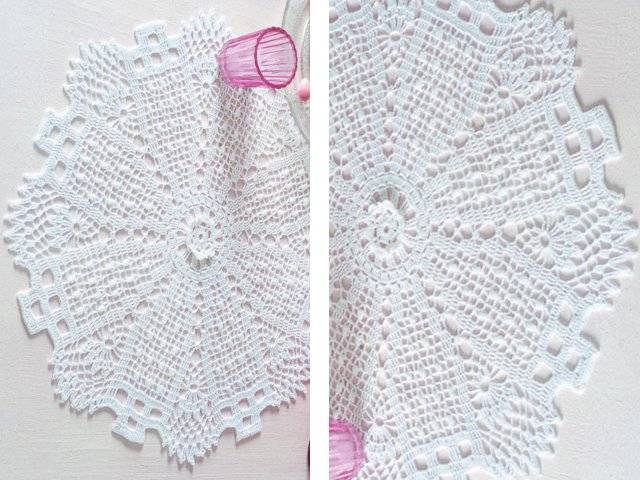
The filet style for many is associated with napkins and tablecloths, and it looks very unusual. When creating this model, squares are used in the sirloin crochet technique, which are interspersed with openwork triangles. The result is a beautiful, airy texture.
Napkin Size:
Diameter 44 cm.
Materials for work:
- yarn (100% cotton; 280 m / 50 g) - 60 g white;
- hook number 1.5.
Knitting pattern:
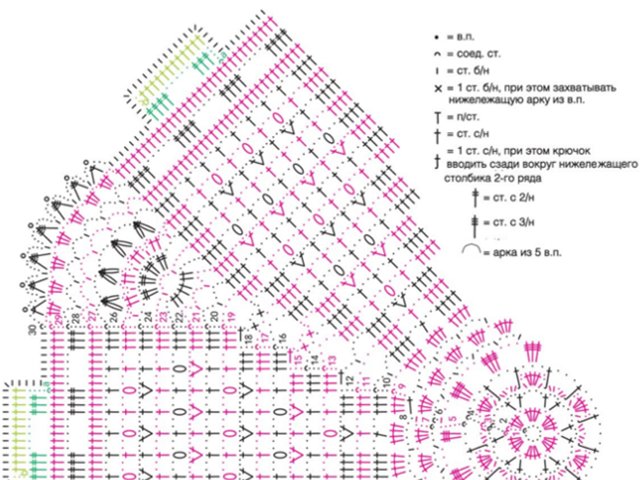

Working process:
Complete the initial chain of 10 vp and lock it in the ring using the connection. Art. Run 3 vp lifting instead of the 1st column, then knit according to the scheme, with each circular row starting from the indicated number of VP lifting and finishing the connection. Art. If necessary, go to the beginning of the next circular row with the connection. Art.
After the 29th row, leave the thread and knit each rectangle separately in shortened rows from a to b (in the diagram, this fragment is highlighted in green). Each time, attach a new thread with a joint. Art.
Then left the working thread to perform the 30th circular row of the scheme.
For greater clarity, only part of the scheme is shown, continue the series by analogy.
The numbers on the diagram indicate circular rows, the letters indicate rows in the forward and reverse directions.
Assembly:
Paste the finished napkin onto the substrate, grabbing a pin with each corner, sprinkle with starch diluted with water and allow to dry.
Small
Crocheting napkins is a fairly quick and exciting experience, and embroidering small napkins can be considered a separate type of hobby. These cute miniature napkins can become hot coasters, tacks, or just play their main role - decorating. How does the crochet of small napkins go? Let’s look at a few interesting examples of knitwear.
- Napkin holders

Beautiful napkins from single motifs will perfectly serve as coasters for glasses and cups, and in addition, they are beautiful and delicate decor elements that will always adorn a table, window sill or cupboard. Let's consider in more detail how to crochet such beauty.
Napkin Size:
Diameter 13 cm.
Materials for work:
- cotton yarn mixed (approx. 140 m / 50 g) - approx. 50 g of blue (= A), bright pink (= B) and mottled blue (= C);
- hook number 4;
- pieces of lilac felt for decoration.
Knitting pattern:

Working process:
Tie 3 times with threads A, B and C the motive, while doing only the 1st – 4th circle. In addition, in every 4th circle. instead of vp perform 1 tbsp. b / n in vp previous circle. row.
Assembly:
Sew a felt decor in the middle of the connected parts, as shown in the photo or randomly.
- Ageless Classics
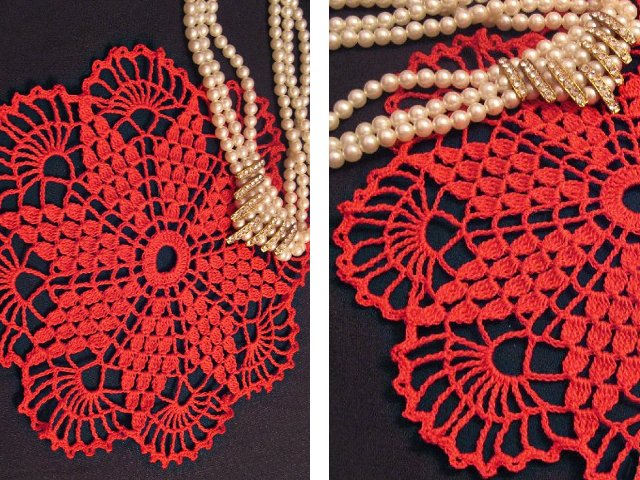
A round napkin with an openwork floral motif is the first thing most people associate with the phrase “knitted napkin”. Such yarn products adorning the house are still held in high esteem, because they look very interesting, add a special touch to the overall style of housing. Let's try to crochet one of these delicate napkins, having examined the detailed description and step-by-step photos.
Materials for work:
- fine yarn;
- a hook suitable for the selected yarn;
- scissors.
Abbreviations in the scheme:
VP - 1 air loop;
Sc - 1 single crochet;
CCH - 1 single crochet;
SS2N - 1 column with two crochets;
SS3N - 1 column with three crochets.
Knitting pattern:

Working process:
Crocheted round napkins are knitted in a circle with the beginning of knitting in the form of a chain of air loops closed in a circle.
1st row: we collect 18 VP. We connect them with a connecting loop.
We make 32 CCHs in the center of the connected circle, at the beginning of the row we do 3 lifting VP. We close the circle with a connecting loop. Next, each row is closed in a circle.
2 row: we knit 6 VP + * 1 CCH through one loop + 3 VP *. Repeat from *.
3 row: we collect 7 VP + * 1 SS2N through three loops +3 VP + 4 SS2N with one vertex + 1 SS2N + 3 VP *. Repeat from *.

4 row: do 7 VP + * through three loops 1 SS2N + 3 VP + 4 SS2N to the arch of the previous row + 3 VP + 4 SS2N to the arch of the previous row + 3 VP + 1 SS2N + 3 VP *. Repeat from *.
5 row: we select 7 VP + * through three loops 1 SS2N + 3 VP + 4 SS2N with one vertex + 3 VP + 4 SS2N with one vertex + 3 VP + 4 SS2N with one vertex + 3 VP + 1 SS2N + 3 VP *. Repeat from *.

6 row: we knit 7 VP + * through three loops 1 SS2N + 3 VP + 4 SS2N with one vertex + 3 VP + 4 SS2N with one vertex + 3 VP + 4 SS2N with one vertex + 3 VP + 4 SS2N with one vertex + 3 VP + 1 CC2H + 3 VP *.Repeat from *.
7 row: we collect 12 VP + * 1 SS3N + 5 VP + 4 SS2N with one vertex + 3 VP + 4 SS2N in a chain of three loops of the last row + 3 VP + 4 SS2N with one vertex + 5 VP + 1 SS3N + 7 VP *. Repeat from *.

8 row: we collect 7 VP + * (1 SS3N + 2 VP), we repeat 8 times + 3 VP + + 4 SS2N in a chain of three loops of the last row + 3 VP + 4 SS2N in a chain of three loops of the last row + 3 VP *. Repeat from *.
9 row: We collect 9 VP + * (1 SS3N + 4 VP), we repeat 8 times + 3 VP + 4 SS2N with one vertex + 3 VP *. Repeat from *.
10 row: We collect 5 VP + * 2 PRS in the same arch + 2 PRS in the next arch + 4 VP *. Repeat from *.

Rectangular
Lovers of handmade table decorations will definitely like crocheting rectangular napkins. These products can easily replace a tablecloth, or become decorative elements on a festive table or ordinary shelves, sideboards, side tables.
- Angel track

Napkin Size:
Diameter 30x85 cm.
Materials for work:
- yarn (100% cotton; 265 m / 50 g) - 100 g white;
- hook number 1.25.
Knitting pattern for the main pattern:
Knit according to the pattern with a filet pattern. Each cell of the pattern consists of 3 p. Empty cells consist of 1 tbsp. s / n (or patent, or art. s 2 / n) and 2 c.p. Filled cells consist of 3 tbsp. s / n (or patent article s / n, or article s 2 / n).


Border
Knit in circular rows according to scheme 2. Each row begins with the one indicated on the scheme
numbers vp and finish the connection. Art. or n / a.

Knitting density:
13 cells wide and 14 p. in height = 10 x 10 cm.
Working process:
Complete the initial chain of 100 vp + 3 vp rise + 2 vp and knit according to scheme 1 in rows in the forward and reverse direction. Perform from the 1st to the 40th p., Then turn the scheme and perform from the 39th to the 1st p. (= 79 p.).
Border:
Tie the finished track around the perimeter in circular rows according to scheme 2. Continue the pattern by analogy to the end of each side. In the 4th row in the middle of each side, perform 1 time rapport A.
Assembly
Stretch the track, moisten and allow to dry.
- Ease

Another model of crocheted napkins in the sirloin technique. It looks very neat due to the delicate pattern on the side and curly framing at the edges. A napkin knits quickly, even if a beginner needlewoman wants to do it herself.
Napkin Size:
Diameter 35x51 cm.
Materials for work:
- yarn (100% cotton; 560 m / 100 g) - 50 g of white;
- hook number 1.5.
Knitting pattern for napkins:
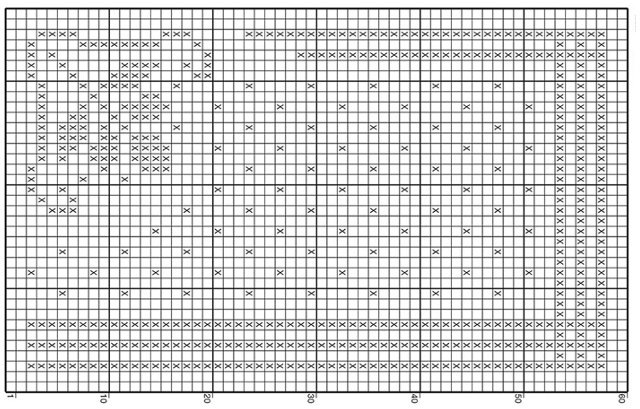

For 1 empty cell, perform 1 tbsp. s / n and 2 vp, for 1 filled cell - 3 tbsp. s / n
Each row begins with 3 vp lifting instead of the 1st art. s / n and end with 1 additional Art. s / n in the 3rd military unit lifting the previous row.
The numbers on the diagram indicate the rows. For clarity, only part of the border scheme is shown, continue the series by analogy.
For the border, knit 1 circular row around the perimeter of the napkin according to the corresponding scheme, while attaching a new thread with 1 conn. Art. On each side to knit art. b / n, at the corners knit in the direction of the arrows.
Working process:
Complete the initial chain of 112 vp + 3 vp lifting and knit sirloin pattern according to the pattern.
Circular row start 1 vp and finish 1 connection. Art.
The extreme cells of the filet pattern are shown once more on the border pattern.
Assembly
Paste the finished napkin on a substrate, sprinkle with starch diluted with water and let dry.
Video tutorial for beginners
Master classes of professionals will help to master the art of crocheting napkins for home. Crocheting a napkin for beginners may seem a rather complicated task, but thanks to video tutorials, understanding this type of needlework is much easier, faster and more enjoyable. In this case, we will talk about a large round napkin with an openwork texture with an interesting peacock feather pattern.
Video - crocheted napkin:


